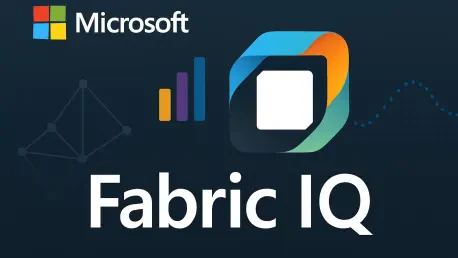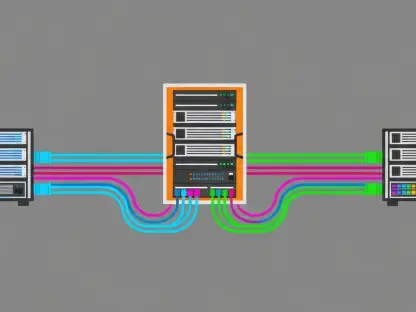In a world where data drives every major business decision, the unveiling of Microsoft Fabric IQ at Ignite this November marks a pivotal moment for enterprise intelligence, showcasing how Microsoft is pushing boundaries with a transformative addition to Microsoft Fabric. Held as one of the premier tech events of the year, Ignite highlighted Fabric IQ as a data platform already embraced by over 28,000 customers, including 80% of the Fortune 500. This isn’t merely an incremental update but a bold reimagining of how fragmented data can be unified into actionable insights. Fabric IQ introduces a sophisticated intelligence layer that embeds semantic understanding and real-time operational capabilities into the fabric of enterprise systems. This allows both AI agents and human decision-makers to operate from a shared understanding of business rules and contexts. Imagine a scenario where discrepancies over fundamental terms like “revenue” or “customer” no longer stall critical decisions across departments. Fabric IQ aims to make such alignment a reality, setting a new standard for how businesses leverage data. This article delves into the essence of this innovation, exploring its core features, its impact on user accessibility, the role of AI in automation, its integration within broader ecosystems, and its strategic significance for the future of enterprise operations.
Breaking Down Semantic Barriers
Fabric IQ addresses a persistent challenge in large organizations: the fragmentation of meaning across departments. Often, teams like sales and marketing interpret key metrics differently, leading to misaligned strategies and wasted resources. This platform introduces a unified semantic layer that organizes data around business concepts rather than disconnected tables or databases. By creating a common language for data, it ensures that all stakeholders, whether human or AI-driven, interpret information consistently. This semantic unification is more than a technical fix; it’s a foundation for clearer communication and more reliable decision-making across an enterprise. The result is a streamlined approach where insights are not only accurate but also relevant to the specific business context, eliminating much of the guesswork that plagues traditional data systems.
At the heart of this transformation lies the Ontology Project, a feature currently in private preview. This component allows business experts to define critical entities such as customers or products, map out their relationships, and connect them directly to real-time data stored in OneLake, the centralized data lake of Microsoft Fabric. What stands out is the accessibility of this tool—there’s no need for deep technical expertise or coding skills to build or refine these models. Non-technical users can visually construct and evolve business ontologies, ensuring that the system reflects the organization’s unique operational reality. This capability lowers barriers significantly, enabling faster adoption and reducing dependency on specialized data teams while maintaining a high degree of accuracy in representing complex business structures.
Democratizing Data for All Users
One of the most compelling aspects of Fabric IQ is its commitment to empowering everyday business users. Historically, interacting with enterprise data required technical know-how, often limiting access to a small group of specialists. Fabric IQ shatters this barrier through intuitive tools like the Data Agent, which is already operational for supported data sources. This feature enables users to query complex datasets using natural language—think of asking a straightforward question in plain English and receiving precise answers without needing to understand SQL or other query languages. The Data Agent pulls insights seamlessly from various systems, including lakehouses, warehouses, and Power BI models, making data accessible to a much broader audience within an organization.
Beyond just simplifying queries, this focus on user accessibility accelerates the pace of decision-making. When employees at all levels can directly engage with data without intermediaries, insights are generated faster, and actions can be taken with greater confidence. The Data Agent also employs advanced reasoning capabilities, such as navigating multi-layered data relationships to address complex business scenarios like supply chain analysis. This ensures that even intricate questions receive comprehensive responses, bridging the gap between raw data and practical application. By placing such powerful tools in the hands of non-technical staff, Fabric IQ fosters a culture of data-driven decision-making that permeates every layer of an enterprise, ultimately enhancing collaboration and efficiency.
Revolutionizing Operations with AI Automation
Fabric IQ takes automation to a new level with the introduction of the Operations Agent, a feature currently in preview that redefines how businesses handle real-time decisions. Unlike traditional automation tools that rely on static rules or merely flag issues for human intervention, these agents actively monitor live data streams through the semantic framework established by the ontology. They assess risks, evaluate options, and execute actions autonomously, all while adhering to predefined business policies. For instance, in a logistics context, an Operations Agent could instantly reroute delivery vehicles based on traffic updates or inventory needs, optimizing operations without requiring constant human input.
Crucially, this automation does not operate in a vacuum; human oversight remains integral to the process. Businesses can define the boundaries of autonomous actions, specifying which decisions require manual approval to maintain control and accountability. This balance between AI independence and governance ensures that automation aligns with organizational priorities while minimizing potential risks. The Operations Agent thus transforms AI from a passive tool into an active participant in operational workflows, scaling expert knowledge across the enterprise. Such capabilities mark a significant shift, positioning AI as a trusted partner in managing the dynamic challenges of modern business environments, ultimately driving efficiency and responsiveness to unprecedented levels.
Connecting the Dots Across Microsoft’s Ecosystem
Fabric IQ does not stand alone but integrates seamlessly within a broader Microsoft IQ ecosystem, amplifying its impact across diverse business functions. This ecosystem includes Work IQ, tied to Microsoft 365, which personalizes user experiences by incorporating data from emails, documents, and collaborative tools like Teams. Similarly, Foundry IQ focuses on building knowledge graphs across organizational content, grounding AI in a managed system of enterprise information. Fabric IQ, with its emphasis on operational and analytical data, complements these layers by unifying real-time insights across varied data types, creating a cohesive semantic foundation that spans previously siloed systems.
This interconnected approach enables AI agents to reason consistently across different domains—whether it’s operational data, personal workflows, or organizational knowledge. Such integration means that insights derived from one area can inform actions in another, breaking down barriers that often hinder holistic decision-making. For example, an AI agent could draw from operational data in Fabric IQ to suggest personalized workflow adjustments via Work IQ, ensuring alignment between individual tasks and broader business goals. This synergy across platforms underscores Microsoft’s vision of a fully integrated intelligence network, where data flows freely and intelligently between systems, enhancing both productivity and strategic coherence across the enterprise landscape.
Shaping the Future of Enterprise Intelligence
Strategically, Fabric IQ positions Microsoft Fabric as the central “operational nervous system” for enterprises, a framework that ties together data, applications, and decision-making processes. By eliminating semantic silos, it drastically reduces the time needed to gain actionable insights, allowing businesses to respond swiftly to emerging challenges or opportunities. Furthermore, its ability to ground AI in structured, business-specific knowledge minimizes errors or misinterpretations, often referred to as “hallucinations” in AI outputs. This reliability makes it a cornerstone for scaling intelligent operations, ensuring that automation and analytics are both accurate and contextually relevant.
Looking ahead, the implications of Fabric IQ are profound, setting the stage for what could be described as an agentic enterprise—a future where AI agents are not just tools but trusted decision-makers embedded in daily operations. With no additional licensing fees required for existing Microsoft Fabric subscribers and a design that encourages incremental adoption through bounded pilots, the platform is accessible for organizations of varying readiness levels. This flexibility, combined with robust governance features, allows businesses to innovate at a comfortable pace while maintaining security and control. Fabric IQ thus emerges as a catalyst for transformation, promising to redefine how enterprises harness data and AI to stay competitive in an increasingly dynamic global market.
Reflecting on a Transformative Leap
Looking back at the unveiling of Fabric IQ at Ignite this November, it became clear that Microsoft had delivered a defining moment in enterprise technology. The platform’s ability to unify fragmented data through semantic intelligence, empower users with accessible tools, and automate decisions with governed AI agents reshaped the landscape of business operations. Its integration within a broader ecosystem further amplified its impact, connecting operational insights with personal and organizational knowledge. As a next step, businesses were encouraged to explore pilot implementations, focusing on specific use cases to test and refine the technology. Experimenting with defined entities like customers or orders offered a practical starting point, ensuring manageable progress. Additionally, leveraging existing investments in Microsoft Fabric provided a cost-effective path forward. With these actionable steps, enterprises could begin to harness the full potential of this innovation, positioning themselves at the forefront of an AI-driven future.









